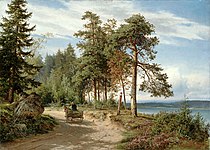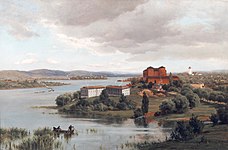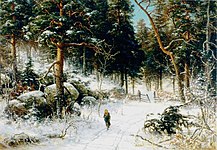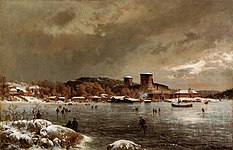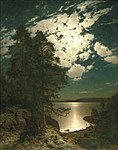Hjalmar Munsterhjelm
Hjalmar Munsterhjelm | |
|---|---|
 Munsterhjelm in 1871–1878 | |
| Born | 19 October 1840 |
| Died | 2 April 1905 (aged 64) Helsinki, Grand Duchy of Finland |
| Education | Member Academy of Arts (1874)[1] |
| Known for | Painting |
| Style | Classicism |
| Movement | Realism |
Magnus Hjalmar Munsterhjelm (19 October 1840 – 2 April 1905) was a Finnish landscape painter. [2]
Biography
Munsterhjelm was born at Toivoniemi Manor of Tuulos, Finland. He was the son of Gustaf Riggert Munsterhjelm (1806-1872) and his wife and Mathilda Charlotta Eleonora von Essen (1818-1895). His father first sent him to the Turku Maritime School. In the early 1860s, he studied art at Düsseldorf with Werner Holmberg (1830-1860) and Oswald Achenbach (1827-1905) and at Karlsruhe under Hans Gude.[3][4]

His painted landscapes were influenced by the romanticism of the Düsseldorf school, often featuring nature as a mood rather than a realistic subject. His landscape "October Evening After the First Snowfall" (1883) was purchased by Alexander III in 1885; the painting is now in the Ateneum in Helsinki.[5][2] Two of his works, "The Evening, in Finland" and "The Night" were displayed at the 1878 Paris Exposition.[6] His work "Evening of the First Spring" was also on display at the 1900 Paris Exposition.[7][2]


He married Olga Mathilda Tanninen (1856–1929) in 1875. They had four children, one of whom was the sculptor John Munsterhjelm (1879–1925). Munsterhjelm became a member of the Royal Swedish Academy of Fine Arts in 1897.[8]
He kept being highly productive all the way until his death in 1905 in Helsinki.[9][2]
In current times his moonlight paintings are some his most famous and popular.[10][11]
Works
- Shepherd in the Alps, 1860
- Road in Finland, 1865
- Peasant Woman from Bayern, 1860s
- Birches in Summer, 1869
- Village Street in Schwartzwald, 1870
- Landscape from Hohenaschau, 1871
- Häme Castle, 1872
- Winter Landscape from Tuulos, 1874
- Olavinlinna (Winter), 1870s
- Moonlight in Barösund, late 1870s
- Moonlit Night, 1883
- October Evening After the First Snowfall, 1883
- Morning Atmosphere (Island View), 1884
- Moonlight, 1885
- Crack Willows, 1897
See also
References
- ^ Directory of the Imperial Academy of Arts 1915, p. 134.
- ^ a b c d Reitala, Aimo (11 October 2005). "Munsterhjelm, Hjalmar (1840 - 1905)". Kansallisbiografia. Retrieved January 1, 2019.
- ^ "Werner Holmberg". Biografiskt lexikon för Finland. Retrieved January 1, 2019.
- ^ Frode Ernst Haverkamp. "Hans Gude". Norsk biografisk leksikon. Retrieved January 1, 2019.
- ^ "Hjalmar Munsterhjelm: October Evening in the Archipelago after First Snow, 1883". www.ateneum.fi. Ateneum Art Museum. 2014. Archived from the original on July 14, 2014. Retrieved June 12, 2014.
- ^ Divers (1878). Catalogue de la section russe à l'Exposition universelle de Paris [Catalogue of the Russian section at the Universal Exhibition of Paris] (in French). Paris: Lahure. Retrieved June 8, 2014.
- ^ L. Baschet (Editor) (1900). Catalogue officiel illustré de l'exposition décennale des beaux-arts de 1889 à 1900 / Exposition universelle de 1900 [Official illustrated catalog of the decennial exhibition of Fine Arts from 1889 to 1900 / 1900 Universal Exhibition] (in French). Paris: impr. Lemercier (Paris). Retrieved June 12, 2014.
{{cite book}}:|last=has generic name (help) - ^ Valjakka, Timo (12 July 2019). "Hämäläisen aatelisperheen lapsesta Hjalmar Munsterhjelmista kasvoi tunnettu taidemaalari, jonka maalauksissa Häme hehkuu romanttisena". Helsingin Sanomat. Retrieved 9 August 2020.
- ^ "Munsterhjelm, John". uppslagsverket. Retrieved January 1, 2019.
- ^ Piri-Lahti, Maarit (13 June 2019). "Yleisö rakasti Munsterhjelmin kuutamoa – meteorologi Seija Paasonen innostui hahtuvapilvistä". Yle. Retrieved 9 August 2020.
- ^ Niskanen, Anne-Maria (20 September 2019). "Maisemataiteen mestarin, Hjalmar Munsterhjelmin kuutamot vetivät Hämeenlinnan taidemuseoon yli 13 000 vierasta". Yle. Retrieved 9 August 2020.
Literary sources
- С. Н. Кондаков (1915). Юбилейный справочник Императорской Академии художеств. 1764-1914 (in Russian). Vol. 2. p. 134.


